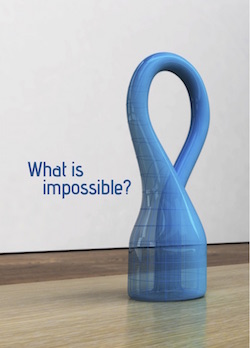

Impossible things are like catnip to mathematicians. If you say something is impossible, they won't be satisfied until they've either got a proof that it is, or an example that it isn't. And understanding why something is impossible can often lead to deeper understanding, contemplations of philosophy and even new mathematics.
Impossible objects
The beautiful image on our postcard (created by Charles Trevelyan) is a Klein bottle – a very strange shape that only has one side (as opposed to an inside and an outside). Strictly speaking Klein bottles cannot actually exist in our three-dimensional word but are possible in four dimensions. You can meet them and find out why in Introducing the Klein bottle, with more details in Inside the Klein bottle. (And if you're really keen you can even knit one.) And if you're wondering how (and perhaps, why) mathematicians think in higher dimensions, you can find out in these articles and their accompanying podcast.
Impossible tasks
Just because something is impossible doesn't meant it's not interesting. In fact, sometimes understanding why something is impossible leads to new mathematics. A parlour game played in Königsberg in the eighteenth century turned out to be impossible to win and Leonard Euler's explanation of why was the start of a whole new area of maths that is now vital to daily life. You can read more in From bridges to networks or watch our very home-made video!
Perhaps the most famous impossible mathematical problem is Fermat's last theorem. Not only did this take over 300 years to prove, it also generated stunning new techniques and was a fantastic story of human endurance. You can read an introduction to the result and its impact on maths, get a glimpse of Andres Wiles' experience of finding the proof and sink your teeth into some of the mathematical details.
And if you'd like to conquer the impossible yourself, why not trisect an angle with origami!
Impossible thoughts
Thinking about mathematical impossibilities can also lead to a deeper understanding of mathematics itself. To find out more, read:
- The Barber's paradox, introducing a famous paradox that had important consequences in maths;
- This is not a carrot, exploring whether contradictions in maths are really as bad as they seem;
- The limits of logic, looking at the curious fact that mathematical truth is in some sense impossible;
- Constructive mathematics, exploring whether we should avoid dubious concepts, such as infinity, in mathematics;
- The philosophy of applied maths, which asks why mathematics itself is so eminently possible.